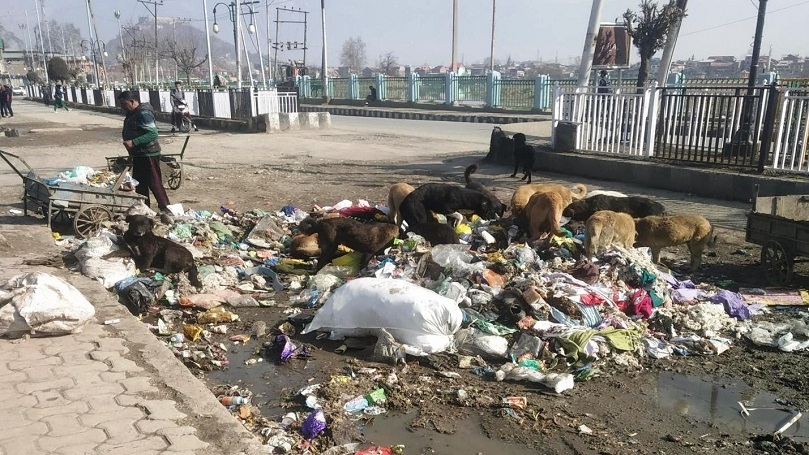
In the backdrop of the recent eco-city announcement, the prevailing picture is only vindicating the global report terming Srinagar as one of the dirtiest cities in the world.
By Farzana Bashir
Three years after the World Health Organisation (WHO) declared it as the 10th most polluted city in the world, Srinagar remains grappling with pollution, even as the Lieutenant Governor lately emphasized several measures being implemented by the government for transforming Srinagar into smart and eco-friendly city.
As per the new rankings, the summer capital of Jammu and Kashmir has been ranked 36th among the cleanest cities in India. For commoners—witness to the faded green city—these rankings are simply undoing the image of the place.
“Srinagar is literally going to dogs,” said Dr. Ashraf Wani, a physician specialist from Srinagar. “While the canines are all over the place, barking and biting us with impunity, administration is acting like sleeping over the falling quality of air, water and soil in Srinagar. Barring some public-private initiatives like Khusarsal restoration campaign, nothing much is visible on the ground.”
Much of this concern is also stemming from the working style of the official cleaning agents.
“Without sounding grumpy, just look at the way these SMC workers clean the roads early in the morning when people, including patients, step out for the healthy walks. They create plumes of dust on streets in the name of sweeping and giving hard time to everyone. It wasn’t always this insensitive. Earlier, we had designated watermen — who would first soak the streets before sweepers chipped in.”
The reckless handling of things is perhaps one of the reasons prompting many to question: How clean is Srinagar?
As per the 2018 WHO study, Srinagar had 113 micrograms per cubic metre of PM 2.5 concentration in the air — making it one of the dirtiest cities in the world.
While the state pollution body turned down this report, Prof. Shakeel Ramshoo, the earth sciences expert, said the study’s findings are accurate.
Previously, a joint-study by Indian Institute of Tropical Meteorology (IITM) and University of Kashmir had found that on some days “the air pollution in Srinagar was worse than that in Delhi and as bad as Kolkata”.
With the latest Swachh survey conducted in January 2020, piles of trash and garbage are being regularly dumped in Srinagar. For a million people living in the summer capital, reportedly there’re only 300 dustbins available.
However, to flip the image of the city bearing the brunt of pollution, LG Manoj Sinha recently launched the ‘Polythene-Free Srinagar’ campaign — urging citizens to eliminate the usage of single-use plastic to lessen its impact on the environment.
Notably, as per 2019 report of the Central Pollution Control Board, 34,367 tonnes of plastic waste is being collected every year in Jammu Kashmir and a sizeable portion is single-use polythene.
“It’s our collective responsibility to include rivers, forests, grasslands, wetlands and all other living species in our future development plans. It is our greatest duty to maintain delicate balance of the environment,” LG Sinha said.
“We must add ‘Rethink Strategy’ in our existing 6R Campaign- Reduce, Reuse, Recycle, Remove, Refuse, and Report to strengthen our resolve for bringing better environmental sustainability in the UT.”
The action plan prepared by SMC for Waste to Energy Plant has been approved, he said, and the government is planning to start door-to-door collection of 100 per cent solid waste by October 2.
“Climate change is real,” Sinha said. “If we do not take action now to protect Mother Nature, our rivers, lakes and localities in future could possibly be buried under the burden of this waste.”
Follow this link to join our WhatsApp group: Join Now
Be Part of Quality Journalism |
Quality journalism takes a lot of time, money and hard work to produce and despite all the hardships we still do it. Our reporters and editors are working overtime in Kashmir and beyond to cover what you care about, break big stories, and expose injustices that can change lives. Today more people are reading Kashmir Observer than ever, but only a handful are paying while advertising revenues are falling fast. |
| ACT NOW |
| MONTHLY | Rs 100 | |
| YEARLY | Rs 1000 | |
| LIFETIME | Rs 10000 | |










